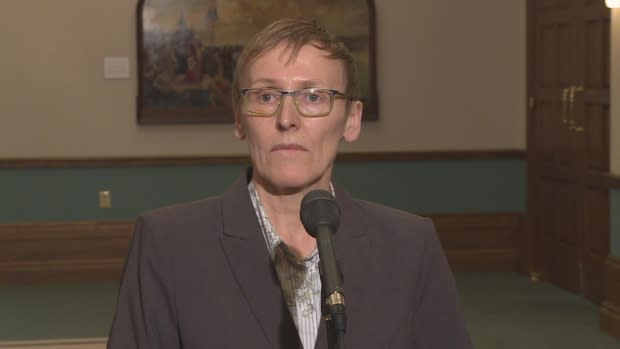PCs accuse government of 'deliberate' inaction on methylmercury at Muskrat
The opposition has accused the government of deliberately doing nothing to protect the food supply from potential methylmercury poisoning at Muskrat Falls.
Premier Dwight Ball said that's certainly not the case, rather safety concerns and a desire for consensus among the Indigenous groups as to how to proceed have held things up.
After government officials testifying at the Muskrat Falls inquiry said it's too late to tackle concerns about rising methylmercury levels at the dam site, PC MHA for Torngat Mountains Lela Evans raised the issue in the House of Assembly on Tuesday.
"What I found devastating today, and it really affected me in the House, is that we're not talking politics. We're talking about the health of the people," Evans told reporters.
Protests prompted changes
Protests in October 2016 called on Nalcor Energy to clear the reservoir at the dam, as residents worried flooding would result in dangerous levels of methylmercury in Lake Melville and contaminate the country food source of fish, seal and seabirds downstream.
Nalcor was ordered to clear more, and a committee of members from Nunatsiavut, NunatuKavut and the Innu Nation was created to look at ways to reduce possible methylmercury contamination.
Two options are removing the soil or capping — covering some of the vegetation — but capping has been seen as the way to go, and the measure was approved by cabinet in January with an estimated cost of "tens of millions of dollars," according to Ball.
But it hasn't happened yet.
'Virtually undetectable' methylmercury
He said safety concerns are part of the hold up – waiting to form an implementation plan with the Indigenous groups another. So far the Innu, the constitutional landholders, have agreed but Ball said they're waiting to hear from the other two.
"Then we need to ask ourselves what are we mitigating against?" he said, noting that capping will have less than a two per cent impact on methylmercury increasing.

"What we see now is no risk to human health, and we're seeing measurements of methylmercury that are virtually undetectable in the reservoir and downstream right now. This new data has been very useful and it's information that we need to share with our Indigenous groups," said Ball, citing the publicly available regular test results from 1,300 samples taken through the new monitoring program.
According to the Canadian Council of Ministers of the Environment, aquatic life is protected at a methylmercury level of 4 ng/L, a threshold used in the program. Samples tested from all sites between October 2016 to May 2019 never exceed 0.200 ng/L.
Inaction is a form of action when it's deliberate. - Lela Evans
Evans said that monitoring is inaccurate.
"That's only been partial flooding, what we have to understand is when they fully flood the dam, the vegetation is going to be underwater and it's going to be a release of the methylmercury. It takes a couple of years for it to build up in the water columns," then contaminate the food chain people rely on, said Evans.
"We're the ones who are going to suffer the greatest."
"When the government chooses to do nothing – deliberately, conscientiously chooses to do nothing, that is actually a form of action. Inaction is a form of action when it's deliberate," said Evans.
Ball said capping is not off the table, although it's not clear what the timeline is as the reservoir is set to be flooded this summer.
Read more from CBC Newfoundland and Labrador

